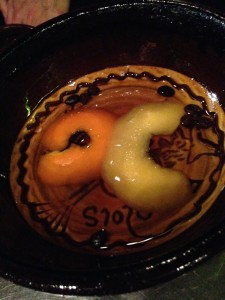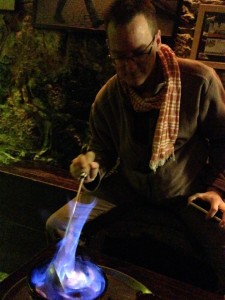
Queimada, the Cocktail that Fire and Witchcraft Made
My spouse loves fire. She lights our dinner table with candles (Back in the days when we had a house and a dinner table. And yes, she has a travel candle for self-catering.). She and her mother-in-law are rapturous when they burn slash at the ranch. Flaming food turns her crank.
And therefore queimada became a quest.
When we read that Galicia had a flaming cocktail, we envisioned something like a Spanish coffee, a glass with a pour of high-octane booze on top and lit a few short seconds for affect.
So wrong were we!
Our adventure started after an evening of contemplative music in the Church of San Paio de Antealtares. “Let’s spark up the night with a queimada!” I had secretly done some research about where to acquire this mysterious drink among the medieval stones Santiago de Compostela’s old city. I steered us toward Fuco Lois.
Often listed as a café, Fuco Lois is a bar, make no mistake. It’s tucked underneath a much pricier restaurant and it’s clandestine. The only sign is formed of stone.
When we enter, there are no customers. The deserted feeling gives the one bartender—a twenty-something Galician woman with long hair and a black t-shirt—a mysterious and slightly sinister air. Are the patrons strung up in a dungeon, curing into human hams?
We want the flaming drink. We’ve read queimada is witches brew, and if we must mortgage our souls, then so be it. We take two of the twenty empty seats around the corner from the entrance.
She of long hair and mysterious air approaches.
“Queimada por favor,” we request.
Her response—rapid, lengthy, accompanied by a series of intricate gestures toward the entrance—is not the “Of course, right away,” we expected.
Are we being asked to depart, because only real Galicians get queimada? We slow her down. We ask questions.
“I can’t serve queimada here.” She points at our table. “I can serve it over there.” She points to a solid rock table and rock benches under a stone ceiling nearer the door.
“For here the flames will be too high.”
The flames will be too high?!
We scuttle right over to the stone table of queimada sacrifice.
“¡Quimeida por favor!” we repeat, once we’re in place.
“Claro, en este momento.” She scoots back behind the bar to begin her witchcraft.
And witchcraft it is. Like all the best spells made with spirits, the ingredients are simple. She handles:

The queimada serving bowl after some drinking has been done. You can see the orange and lemon peel are whole, not technically zested. The brown nutlike objects are the whole coffee beans.
- Aguardiente, an unaged brandy of Galicia (If you imagine a fruiter version of Italy’s grappa, then you have a sense for the Galician firewater. Hers comes from a milk bottle that’s kept away from the rest of the liquor. )
- Sugar
- A lemon
- An orange
- Cinnamon
- Coffee beans
These she combines by mixing sugar—Five? Six? Seven tablespoons? She’s quick, our princess of potions!—with the aguardiente in a big terra cotta bowl. She eases half the lemon peel and half of the orange peel into the cauldron. She takes a light palm-full of coffee beans from the espresso grinder (about 20 beans by our estimate) and drops them in one by one while stirring the mixture. We don’t see the ground cinnamon go in, but it’s there. Surely she didn’t make that flavor by magic alone.
A very long, metal-handled ladle appears in her hand, and she heads back to the table of sacrifice with the bowl, a lighter, sheets of paper, and two small terra cotta cups on a platter.
“Are you ready?” She is practicing her English.
Ready for what, exactly?
She hands us each a paper.
“Repeat with me as I say the spell.”
We’ve read about this: traditionally there is a saying—a conxuro, a spell—that is repeated whenever queimada is made. What we were not expecting is that the saying—Is it a poem? I cannot judge these things well in Galician—would be a page of closely packed type.
She interprets my contemplative silence as readiness.
Click, goes the lighter.
Whoosh! Goes the flame.
A two-foot pillar of blue fire erupts from the bowl!
Our thaumaturge, our lady of flame, now our favorite bartender in all of Spain, incants:
Mouchos, curuxas, sapos e bruxas.
Demos, trasgos e diaños,
espíritos das neboadas veigas.
Corvos, píntegas e meigas:
feitizos das menciñeiras.
Podres cañotas furadas,
fogar dos vermes e alimañas.
Lume das Santas Compañas,
mal de ollo, negros meigallos,
cheiro dos mortos, tronos e raios.
Ouveo do can, pregón da morte;
fuciño do sátiro e pé do coello.
Pecadora lingua da mala muller
casada cun home vello.
She ladles the liquid into the air above the bowl and pours it back in. The pour, the ladle, and the ladle’s handle are all aflame! She continues, ladling, lifting, flaming.
Averno de Satán e Belcebú,
lume dos cadáveres ardentes,
corpos mutilados dos indecentes,
peidos dos infernais cus,
muxido da mar embravecida.
Barriga inútil da muller solteira,
falar dos gatos que andan á xaneira,
guedella porca da cabra mal parida.
Quimeida splatters out of the bowl, onto the platter, onto the table, even onto the floor. No matter! Let them burn! We are incanting still:
Con este fol levantarei
as chamas deste lume
que asemella ao do Inferno,
e fuxirán as bruxas
a cabalo das súas escabas,
índose bañar na praia
das areas gordas.
¡Oíde, oíde! os ruxidos
que dan as que non poden
deixar de queimarse no augardente
quedando así purificadas.
E cando este beberaxe
baixe polas nosas gorxas,
quedaremos libres dos males
da nosa alma e de todo embruxamento.
Do we want to ladle some? Of course we do! In turn, she passes us each the ladle, still working our incantation:
Forzas do ar, terra, mar e lume,
a vós fago esta chamada:
se é verdade que tendes máis poder
que a humana xente,
eiquí e agora, facede que os espíritos
dos amigos que están fóra,
participen con nós desta Queimada.
When finally the spell is finished she, still ladling, cautions us:
“Don’t drink it too soon, as it is very hot. ¡Caliente!”
The fire dies out and she ladles our cups full.
I like my coffee and tea with lots of steam, so I am first to put the cup to my lips.
Quimeida has a strong caramel flavor, and the cinnamon fits in nicely. The orange and lemon give an essence that was mellower than raw zest, but much sharper than what comes from baking zest into pastry. The sharper zest wards off the idea that quimeida tastes like a rum-soaked Christmas cake. The fruit from the brandy gives some aroma of flowers. The coffee beans are a masterstroke, contributing a darker, toasted essence to the whole mixture that flaming liquor would not have on its own.
Pour me another!
Our bartender seems to approve of our interest in the local potion, and comes back to help us understand.
The spell is long to help make sure that the right amount of alcohol is burned off. Some bartenders have a short spell and therefore do a short burn, but she doesn’t like her quimeida that way.
“Too strong!”
In different parts of Galicia, people use different fruits. Apple, for example, and some people have even experimented with banana.
I ask to smell the aguradente. The bottle she has—It’s completely unlabeled. Moonshine, I expect—is wonderfully rich in apple, green grape, and kiwi aromas.
The spells vary a little from place to place, but the spell is something that Galicians appear to agree upon. Our version differs by only one word from the one published in Wikipedia, which also offers an English translation for anyone who wants their spell spelled out.
We are intrigued to learn that most traditionally, quimeida is served in a pumpkin. If you want to be super-traditional about serving quimeida, then do it on St. John’s night—the Galicians call it “witches’ night”—on the 23rd of June. That makes it a perfect beverage for your Longest-Day-of-the-Year celebrations.
Alison is adamant about her witches brew: “We’re going to serve this at home!” Then looking at the surrounds she amends herself. “Outside. On the patio.”
When we have a home, I add, silently.
What’s my source of aguardiente in Oregon?
Chris



Recent Comments